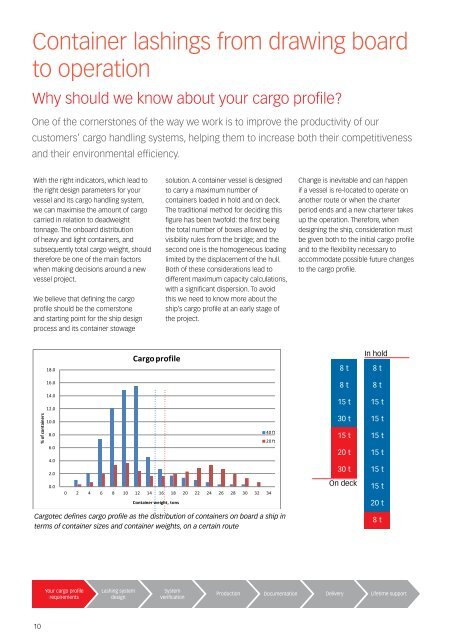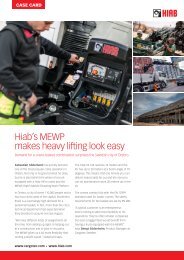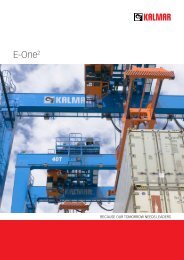Container securing systems Product catalogue - Cargotec, Inc.
Container securing systems Product catalogue - Cargotec, Inc.
Container securing systems Product catalogue - Cargotec, Inc.
Create successful ePaper yourself
Turn your PDF publications into a flip-book with our unique Google optimized e-Paper software.
<strong>Container</strong> lashings from drawing board<br />
to operation<br />
Why should we know about your cargo profile?<br />
One of the cornerstones of the way we work is to improve the productivity of our<br />
customers’ cargo handling <strong>systems</strong>, helping them to increase both their competitiveness<br />
and their environmental efficiency.<br />
With the right indicators, which lead to<br />
the right design parameters for your<br />
vessel and its cargo handling system,<br />
we can maximise the amount of cargo<br />
carried in relation to deadweight<br />
tonnage. The onboard distribution<br />
of heavy and light containers, and<br />
subsequently total cargo weight, should<br />
therefore be one of the main factors<br />
when making decisions around a new<br />
vessel project.<br />
We believe that defining the cargo<br />
profile should be the cornerstone<br />
and starting point for the ship design<br />
process and its container stowage<br />
% of containers<br />
solution. A container vessel is designed<br />
to carry a maximum number of<br />
containers loaded in hold and on deck.<br />
The traditional method for deciding this<br />
figure has been twofold: the first being<br />
the total number of boxes allowed by<br />
visibility rules from the bridge; and the<br />
second one is the homogeneous loading<br />
limited by the displacement of the hull.<br />
Both of these considerations lead to<br />
different maximum capacity calculations,<br />
with a significant dispersion. To avoid<br />
this we need to know more about the<br />
ship’s cargo profile at an early stage of<br />
the project.<br />
<strong>Cargotec</strong> defines cargo profile as the distribution of containers on board a ship in<br />
terms of container sizes and container weights, on a certain route<br />
10<br />
18.0<br />
16.0<br />
14.0<br />
12.0<br />
10.0<br />
8.0<br />
6.0<br />
4.0<br />
2.0<br />
0.0<br />
Your cargo profile<br />
requirements<br />
0 2 4 6 8 10 12 14 16 18 20 22 24 26 28 30 32 34<br />
Lashing system<br />
design<br />
Cargo profile<br />
<strong>Container</strong> weight, tons<br />
System<br />
verification<br />
40 ft<br />
20 ft<br />
Change is inevitable and can happen<br />
if a vessel is re-located to operate on<br />
another route or when the charter<br />
period ends and a new charterer takes<br />
up the operation. Therefore, when<br />
designing the ship, consideration must<br />
be given both to the initial cargo profile<br />
and to the flexibility necessary to<br />
accommodate possible future changes<br />
to the cargo profile.<br />
8 t<br />
8 t<br />
15 t<br />
30 t<br />
15 t<br />
20 t<br />
30 t<br />
On deck<br />
In hold<br />
8 t<br />
8 t<br />
15 t<br />
15 t<br />
15 t<br />
15 t<br />
15 t<br />
15 t<br />
20 t<br />
<strong>Product</strong>ion Documentation Delivery Lifetime support<br />
8 t




